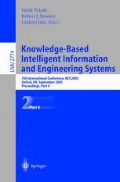Abstract
Computer-based analysis of bio-sequences has significant impact in the field of biology. With genome projects generating massive volumes of genetic data, there is a rapidly widening gap between data collection capabilities and the ability to analyze them. Genome databases consist of sequences, which represent biological entities. This paper presents a combinatorial method of discovering active regions in such non-redundant genome databases. Patterns with expressive power in the class of regular languages are considered for representing active regions. Discovering such active sites will aid a biologist to analyze homologies hidden in the bio-sequences.
Access this chapter
Tax calculation will be finalised at checkout
Purchases are for personal use only
Preview
Unable to display preview. Download preview PDF.
References
Fayyad, U., Haussler, D., Stolorz, P.: Mining Scientific Data. Communications of the ACM 39(11), 51–57 (1996)
Houle, J.L., Cadigan, W., Henry, S., Pinnamaneni, A., Lundahl, S.: Database Mining in the Human Genome Initiative. Trends in Biotechnology 10(1-2), 31–45 (2000)
Collins, F., Patrinos, A., Jordan, E., Chakravarti, A., Gesteland, R., Walters, L.: Goals for the human genome project: 1998-2003. Science 282(5389), 22–29 (1998)
Setubul, J., Meidanis, J.: Introduction to computational Molecular Biology, pp. 33–38. PWS Publishing Company (1997)
Tompa, M.: Technical Report# 2000-06-01. Lecture Notes on Biological Sequence Analysis, pp. 08-55
Gusfield, D.: Algorithms on Strings, Trees and Sequences: Computer Science and Computational Biology. Cambridge University Press, Cambridge (1997)
Cochran, W.G.: Sampling Techniques. Wiley, Chichester (1977)
Giegerich, R., Kurtz, S.: From Ukkonen to McCreight and Weiner: A Unifying View of Linear-Time Suffix Tree Construction. Algorithmica, 19, 331–353 (1997)
Maab, M.: Suffix Trees and their applications. Wiley, Chichester (1999)
Bairoch, A., Apweiler, R.: The SwissProt protein sequence data bank and its supplement TrEMBL in 1998. Nucleic Acids Research (1998)
Brazma, A., Jonassen, I., Eidhammer, I., Gilbert, D.: Approaches to the automatic discovery of patterns in bio-sequences. Technical report, Department of Informatics, University of Bergen, Norway (November 1997)
Taylor, W.R.: Comparison of bio-sequences with templates. Journal of Molecular Biology 188, 233–258 (1989)
Floratos, A., Jurisica, I., Rigoutsos, I.: Knowledge Discovery in Biological Domains. In: Proceedings of the sixth ACM SIGKDD international conference on Knowledge Discovery and data mining, January 2000, vol. 39, pp. 13–74 (2000)
Roytberg, M.A.: Computer Applications in the Bioscience 8, 57–64 (1992)
Author information
Authors and Affiliations
Editor information
Editors and Affiliations
Rights and permissions
Copyright information
© 2003 Springer-Verlag Berlin Heidelberg
About this paper
Cite this paper
Ramesh, K., Nair, S.B. (2003). Discovering Active Regions in Non-redundant Genome Databases. In: Palade, V., Howlett, R.J., Jain, L. (eds) Knowledge-Based Intelligent Information and Engineering Systems. KES 2003. Lecture Notes in Computer Science(), vol 2774. Springer, Berlin, Heidelberg. https://doi.org/10.1007/978-3-540-45226-3_127
Download citation
DOI: https://doi.org/10.1007/978-3-540-45226-3_127
Publisher Name: Springer, Berlin, Heidelberg
Print ISBN: 978-3-540-40804-8
Online ISBN: 978-3-540-45226-3
eBook Packages: Springer Book Archive

